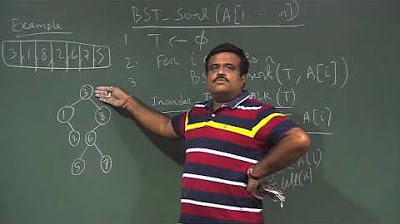Lec-54: Deletion from Binary Search Tree(BST) with Example | Data Structure
Summary
TLDRIn this video, the process of deleting elements from a binary search tree (BST) is explained in detail. The video covers three main cases: deleting a leaf node (with no children), deleting a node with a single child (by connecting the child to the node’s grandparent), and deleting a node with two children (by replacing it with either the inorder predecessor or successor). The script is accompanied by practical examples and visual explanations to clarify the steps involved. By following these methods, the binary search tree structure is preserved, ensuring a proper deletion process.
Takeaways
- 😀 Deleting elements from a binary search tree (BST) is an important topic in competitive exams and college/university exams.
- 😀 A BST is a binary tree where each node has a value, and the left child is smaller, while the right child is larger.
- 😀 There are three main cases for deleting a node in a BST: leaf node, node with one child, and node with two children.
- 😀 A leaf node has no children, so to delete it, simply remove the node without making any additional changes to the tree.
- 😀 If a node has one child, delete the node and connect its child directly to the node's grandparent.
- 😀 For nodes with two children, two methods are used: in-order predecessor (largest node in the left subtree) or in-order successor (smallest node in the right subtree).
- 😀 In the in-order predecessor method, the largest node in the left subtree is chosen to replace the node to be deleted.
- 😀 In the in-order successor method, the smallest node in the right subtree is chosen to replace the node to be deleted.
- 😀 After deletion of nodes with two children, ensure that the BST property is maintained by correctly linking the replaced node's child to the correct grandparent.
- 😀 These deletion techniques are essential for maintaining the BST structure and ensuring that the tree remains balanced for future operations.
Q & A
What is the main topic of this video?
-The main topic of the video is how to delete an element from a binary search tree (BST).
What is the first step in deleting a node in a BST?
-The first step is to identify the type of node you are deleting: whether it is a leaf node or a non-leaf node.
What happens when you delete a leaf node in a BST?
-When you delete a leaf node, you simply remove it from the tree without needing to make any further changes, as no BST properties are violated.
What is a non-leaf node?
-A non-leaf node is a node that has at least one child. It can have either one or two children.
How do you handle deleting a node with one child?
-When deleting a node with one child, you remove the node and connect its child to its grandparent (the parent of the node’s parent).
What should be done when deleting a node with two children?
-To delete a node with two children, you replace it with either the largest element from the left subtree (inorder predecessor) or the smallest element from the right subtree (inorder successor).
What is an inorder predecessor?
-An inorder predecessor is the largest element in the left subtree of the node to be deleted. It is the element that comes just before the node in an inorder traversal.
What is an inorder successor?
-An inorder successor is the smallest element in the right subtree of the node to be deleted. It is the element that comes just after the node in an inorder traversal.
What happens if you delete a node with two children and use the inorder predecessor method?
-If you delete a node with two children and use the inorder predecessor method, you replace the deleted node with the largest element from its left subtree and maintain the BST properties.
What happens if you delete a node with two children and use the inorder successor method?
-If you delete a node with two children and use the inorder successor method, you replace the deleted node with the smallest element from its right subtree and adjust the tree accordingly.
Outlines

Dieser Bereich ist nur für Premium-Benutzer verfügbar. Bitte führen Sie ein Upgrade durch, um auf diesen Abschnitt zuzugreifen.
Upgrade durchführenMindmap

Dieser Bereich ist nur für Premium-Benutzer verfügbar. Bitte führen Sie ein Upgrade durch, um auf diesen Abschnitt zuzugreifen.
Upgrade durchführenKeywords

Dieser Bereich ist nur für Premium-Benutzer verfügbar. Bitte führen Sie ein Upgrade durch, um auf diesen Abschnitt zuzugreifen.
Upgrade durchführenHighlights

Dieser Bereich ist nur für Premium-Benutzer verfügbar. Bitte führen Sie ein Upgrade durch, um auf diesen Abschnitt zuzugreifen.
Upgrade durchführenTranscripts

Dieser Bereich ist nur für Premium-Benutzer verfügbar. Bitte führen Sie ein Upgrade durch, um auf diesen Abschnitt zuzugreifen.
Upgrade durchführenWeitere ähnliche Videos ansehen

[SER222] M03_02 Implementation (6/10): The DeleteMin Operation

Lec-101: Insertion in B-Tree with example in Hindi

Lecture 25 : Binary Search Tree (BST) Sort

L-3.7: Introduction to Trees (Binary Tree, Almost Complete Binary Tree, Full BT, Complete BT, BST)

Lec-62: Introduction to Red-Black Tree | Data Structure for Beginners

Virtual University CS301 Data Structure Short Lecture 19 || CS301 Short Lectures
5.0 / 5 (0 votes)
